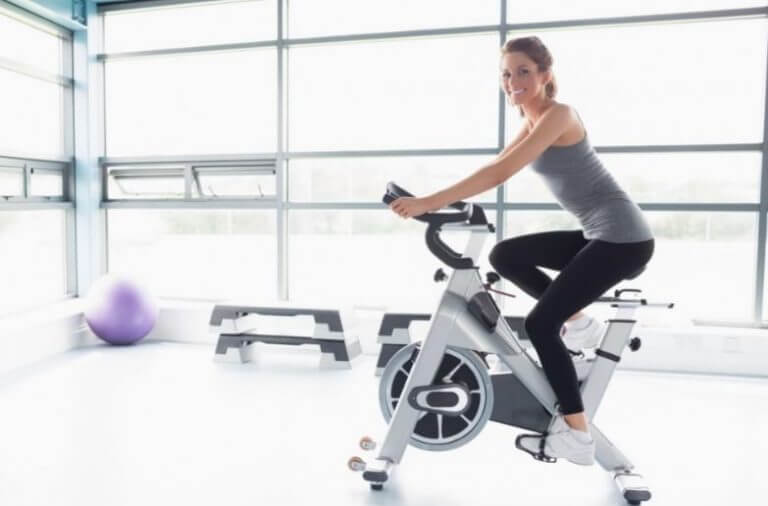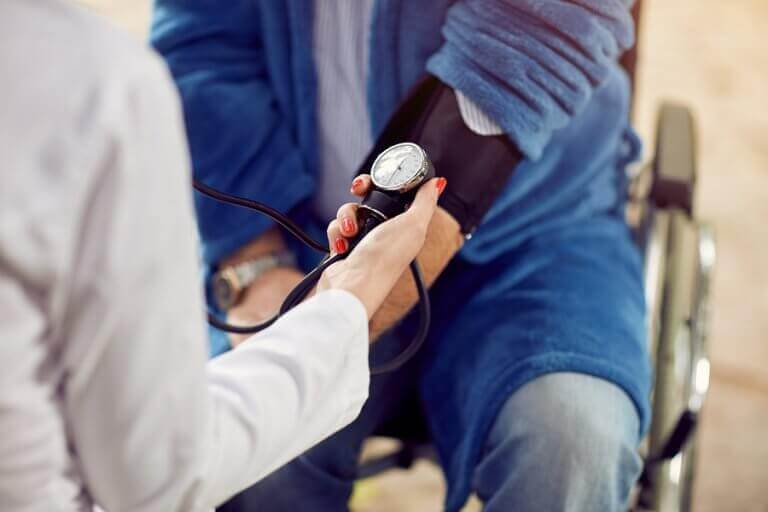The Exercise Stress Test: What's it For?

The exercise stress test is a common examination for athletes, although doctors also perform it on people with cardiorespiratory problems. In this article, we’ll tell you all about the exercise stress test and when you should complete it.
What’s an exercise stress test?
Doctors use the exercise stress test to determine if a patient is suffering from coronary heart disease such as angina pectoris. The test analyzes the patient’s heart rate during exercise or while exerting physical effort.
Some other names for the exercise stress test are exercise tolerance tests, exercise electrocardiogram (ECG) and stress or treadmill test. This medical control provides information about the condition of the body’s most important muscle.
The main purpose of the stress test is to reveal and detect heart conditions that don’t show any symptoms. It’s also useful to identify diseases that are impossible to recognize while our heart is at rest, but that start appearing when we exercise.
For example, if a person suffers from some kind of heart condition, a blockage of the arteries won’t allow them to perform certain movements such as running or pedaling at a high speed.
The exercise stress test doesn’t measure our physical endurance, instead, it focuses on our heart rate and blood pressure during exercise. It diagnoses disease and allows doctors to offer treatments.
Why should people take an exercise stress test?
The main reasons to undergo an exercise ECG are:
- Monitor the heart’s response to physical effort.
- Determine the heart rate and know if the heart is beating regularly.
- Rule out anomalies and heart disease, mainly for people with a family history of heart problems.
- Diagnose arrhythmias or coronary illnesses.
- Approve an intense exercise routine for athletes (both professionals and amateurs).
- Serve as a guide in the selection of a treatment for any heart condition.

A doctor may recommend taking an exercise stress test if the patient is worried about the way their heart works, if any other member of the family suffers from heart problems or if their preferred gym asks for a medical certificate to begin training in their facilities.
How is an exercise stress test performed?
During an exercise EKG or treadmill test, the patient must exert as much physical effort as they can endure, until reaching the fatigue threshold or their maximum resistance level.
In order for the test to be accurate, the patient must wear appropriate clothes and shoes to work out, and they shouldn’t eat a heavy meal during the three hours prior to the test. It’s important to note that it’s not a good idea to perform the test on an empty stomach either. Patients should also avoid drinking alcoholic beverages or coffee and exercising vigorously in the 12 hours leading up to the test.
Before the test begins, the doctor will attach flat patches known as electrodes to the chest of the patient. These electrodes measure the patient’s heart beats. In some places, the doctors also attach electrodes to the patient’s wrists. If the patient feels dizzy, nauseous or suffers chest pain, cold sweats and shortage of breath at any moment during the tests, they should communicate this to the specialist immediately.
Test procedure
To perform the test, the patient uses a treadmill or static bike and starts at a slow speed. They increase the speed progressively until they’re pedaling at a high speed or running (depending on the machine they’re using).
The intensity of the exercise increases every three minutes. This is an automatic feature. As a result, the heart begins to beat faster and the doctor can monitor the patient’s blood pressure. If the patient can’t endure the effort, the intensity of the exercise decreases and the doctor moves on to the recovery phase (light exercise).

If this doesn’t happen, the exercise stress test is performed entirely, for about 60 minutes. This doesn’t mean that the patient must run at full speed for one whole hour; it just means that the whole session lasts 60 minutes.
By the end of the test, the patient enters the ‘relaxation phase’ for a few minutes. This serves to bring their heart rate and breathing back to normal. After an exercise stress test, the patient can return to their regular activities with no contraindications.
The test results can be normal (the test was completed, the patient’s heart rate didn’t exceed the limit and the rhythm is adequate) or abnormal (the test was not completed, arrhythmias were identified or the patient experienced cardiorespiratory overexertion).
You don’t have to be an elite athlete to take an exercise stress test. Everyone should take it at least once to learn about their heart’s condition.
The exercise stress test is a common examination for athletes, although doctors also perform it on people with cardiorespiratory problems. In this article, we’ll tell you all about the exercise stress test and when you should complete it.
What’s an exercise stress test?
Doctors use the exercise stress test to determine if a patient is suffering from coronary heart disease such as angina pectoris. The test analyzes the patient’s heart rate during exercise or while exerting physical effort.
Some other names for the exercise stress test are exercise tolerance tests, exercise electrocardiogram (ECG) and stress or treadmill test. This medical control provides information about the condition of the body’s most important muscle.
The main purpose of the stress test is to reveal and detect heart conditions that don’t show any symptoms. It’s also useful to identify diseases that are impossible to recognize while our heart is at rest, but that start appearing when we exercise.
For example, if a person suffers from some kind of heart condition, a blockage of the arteries won’t allow them to perform certain movements such as running or pedaling at a high speed.
The exercise stress test doesn’t measure our physical endurance, instead, it focuses on our heart rate and blood pressure during exercise. It diagnoses disease and allows doctors to offer treatments.
Why should people take an exercise stress test?
The main reasons to undergo an exercise ECG are:
- Monitor the heart’s response to physical effort.
- Determine the heart rate and know if the heart is beating regularly.
- Rule out anomalies and heart disease, mainly for people with a family history of heart problems.
- Diagnose arrhythmias or coronary illnesses.
- Approve an intense exercise routine for athletes (both professionals and amateurs).
- Serve as a guide in the selection of a treatment for any heart condition.

A doctor may recommend taking an exercise stress test if the patient is worried about the way their heart works, if any other member of the family suffers from heart problems or if their preferred gym asks for a medical certificate to begin training in their facilities.
How is an exercise stress test performed?
During an exercise EKG or treadmill test, the patient must exert as much physical effort as they can endure, until reaching the fatigue threshold or their maximum resistance level.
In order for the test to be accurate, the patient must wear appropriate clothes and shoes to work out, and they shouldn’t eat a heavy meal during the three hours prior to the test. It’s important to note that it’s not a good idea to perform the test on an empty stomach either. Patients should also avoid drinking alcoholic beverages or coffee and exercising vigorously in the 12 hours leading up to the test.
Before the test begins, the doctor will attach flat patches known as electrodes to the chest of the patient. These electrodes measure the patient’s heart beats. In some places, the doctors also attach electrodes to the patient’s wrists. If the patient feels dizzy, nauseous or suffers chest pain, cold sweats and shortage of breath at any moment during the tests, they should communicate this to the specialist immediately.
Test procedure
To perform the test, the patient uses a treadmill or static bike and starts at a slow speed. They increase the speed progressively until they’re pedaling at a high speed or running (depending on the machine they’re using).
The intensity of the exercise increases every three minutes. This is an automatic feature. As a result, the heart begins to beat faster and the doctor can monitor the patient’s blood pressure. If the patient can’t endure the effort, the intensity of the exercise decreases and the doctor moves on to the recovery phase (light exercise).

If this doesn’t happen, the exercise stress test is performed entirely, for about 60 minutes. This doesn’t mean that the patient must run at full speed for one whole hour; it just means that the whole session lasts 60 minutes.
By the end of the test, the patient enters the ‘relaxation phase’ for a few minutes. This serves to bring their heart rate and breathing back to normal. After an exercise stress test, the patient can return to their regular activities with no contraindications.
The test results can be normal (the test was completed, the patient’s heart rate didn’t exceed the limit and the rhythm is adequate) or abnormal (the test was not completed, arrhythmias were identified or the patient experienced cardiorespiratory overexertion).
You don’t have to be an elite athlete to take an exercise stress test. Everyone should take it at least once to learn about their heart’s condition.
All cited sources were thoroughly reviewed by our team to ensure their quality, reliability, currency, and validity. The bibliography of this article was considered reliable and of academic or scientific accuracy.
- Uribe, M. H. J. (2016). Prueba de esfuerzo. English Journal. https://doi.org/10.1016/B978-84-9022-911-8/00013-5
This text is provided for informational purposes only and does not replace consultation with a professional. If in doubt, consult your specialist.








